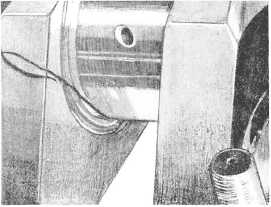ENGINEMAN 1 & C
Broken or bent crankshafts may be caused by
the improper functioning of a torsional vibration
damper. Vibration dampers are mounted on the
crankshafts of some engines to reduce the tor-
sional vibrations set up within the crankshaft and
to ensure a smoother running engine. If a damper
functions improperly, torsional vibrations may
rupture the internal structure of the shaft.
The principle of operation is similar in most
dampers, yet their construction and their
component parts vary somewhat. If the engine is
equipped with a vibration damper, the engine in-
struction manual must be consulted for informa-
tion on type, construction, and maintenance of
the damper.
In most engines, one end of the crankshaft is
flanged to receive the damper, the damper being
bolted or doweled onto the flange. A damper must
be fastened securely to the crankshaft at all times
during engine operation; otherwise, the damper
will not control the crankshaft vibrations.
Small dampers are usually grease-packed,
while larger ones frequently receive lubrication
from the main oil system. Dampers that are grease
lubricated must have the grease changed
periodically, as specified in the manufacturer’s
instructions. If the assembly is of the elastic type,
it must be protected from fuel, lube oil, grease,
and excessive heat, all of which are detrimental
to the rubber.
Excessive rumbling at certain engine speeds
may indicate that the damper is not functioning
properly. You must learn to distinguish between
this and the normal noise usually heard in some
engines during the first and last few revolutions
when the engine is starting or stopping. This noise
is normal, it is due to the large designed clearances
in the damper and is not a sign of impending
trouble.
Crankshaft breakage or bending may be the
result of excessive bearing clearances. Excessive
clearance in one main bearing may place practic-
ally all of the load on another main bearing. Flex-
ing of the crankshaft under load may result in
fatigue and eventual fracture of the crank web.
(See figure 3-19.) Excessive bearing clearance may
be caused by the same factors that cause journal
bearing failure. Furthermore, off-center and out-
of-round journals tend to scrape off bearing
material. This leads to excessive wear and to the
increase of the clearance between the shaft and
Figure 3-19.—Cracked crank web.
121.3
bearing. You can minimize the possibility of jour-
nal out-of-roundness by taking measures to pre-
vent improper lubrication, journal bearing failure,
overspeeding or overloading of the engine,
excessive crankshaft deflection, and misalignment
of parts.
Crankshaft bending breakage (out-of-
roundness) may also result from excessive
crankshaft deflection. Excessive shaft deflection,
caused by improper alignment between the driven
unit and the engine, may result in a broken or bent
shaft along with considerable other damage to
bearings, connecting rods, and other parts. Ex-
cessive crankshaft deflection may also be caused
by overspeeding an engine. The amount of deflec-
tion of a crankshaft may be determined by the
use of a straight gage.
The straight gage is merely a dial-reading
inside micrometer used to measure the variation
in the distance between adjacent crank webs where
the engine shaft is barred over. When installing
the gage, or indicator, between the webs of a
crank throw, place the gage as far as possible from
the axis of the crankpin. The ends of the indicator
should rest in the prick-punch marks in the crank
webs. If these marks are not present, you must
make them so that the indicator may be placed
in its correct position. Consult the manufacturer’s
technical manual for the proper location of new
marks.
3-32

